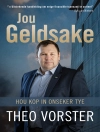November 11th 2003 saw a landmark event take place in London. As
the first conference designed for quants by quants the Quantitative
Finance Review 2003, moved away from the anonymous bazaars that
have become the norm, and instead delivered valuable information to
market practitioners with the greatest interest. The roster of
speakers was phenomenal, ranging from founding fathers to bright
young things, discussing the latest developments, with a specific
emphasis on the burgeoning field of credit derivatives. You really
had to be there. Until now, at least.
The Best of Wilmott 1: Including the latest research from
Quantitative Finance Review 2003 contains these first-class
articles, originally presented at the QFR 2003, along with a
collection of selected technical papers from Wilmott magazine. In
publishing this book we hope to share some of the great insights
that, until now, only delegates at QFR 2003 were privy to, and give
you some idea why Wilmott magazine is the most talked about
periodical in the market.
Including articles from luminaries such as Ed Thorp, Jean-Philippe
Bouchaud, Philipp Schoenbucher, Pat Hagan, Ephraim Clark, Marc
Potters, Peter Jaeckel and Paul Wilmott, this collection is a must
for anyone working in the field of quantitative finance. The
articles cover a wide range of topics:
* Psychology in Financial Markets
* Measuring Country Risk as Implied Volatility
* The Equity-to-Credit Problem
* Introducing Variety in Risk Management
* The Art and Science of Curve Building
* Next Generation Models for Convertible Bonds with Credit
Risk
* Stochastic Volatility and Mean-variance Analysis
* Cliquet Options and Volatility Models
And as they say at the end of (most) Bond movies The Best of
Wilmott… will return on an annual basis.
Содержание
Introduction (Paul Wilmott).
I. Education in Quantitative Finance (Riaz Ahmad).
II. Financial CAD (Owen Walsh).
III, Quantitative Finance Review 2003 (Dan Tudball).
Chapter 1: Rewind (Dan Tudball)
Chapter 2: In for the Count (Dan Tudball).
Chapter 3: A Perspective on Quantitative Finance: Models for
Beating the Market (Ed Thorp).
Chapter 4: Psychology in Financial Markets (Henriëtte
Prast).
Chapter 5: Credit Risk Appraisal: From the Firm Structural
Approach to Modern Probabilistic Methodologies (Hugues E. Pirotte
Spéder).
Chapter 6: Modelling and Measuring Sovereign Credit Risk
(Ephraim Clark).
Chapter 7: The Equity-to-credit Problem (or the Story of
Calibration, Co-calibration and Re-calibration) (Elie Ayache).
Chapter 8: Measuring Country Risk as Implied Volatility (Ephraim
Clark).
Chapter 9: Next Generation Models for Convertible Bonds with
Credit Risk (E. Ayache, P. A. Forsyth and K. R. Vetzal).
Chapter 10: First to Default Swaps (Antony Penaud and James
Selfe).
Chapter 11: Taken to the Limit: Simple and Not-so-simple Loan
Loss Distributions (Philipp J. Schönbucher)
Chapter 12: Sovereign Debt Default Risk: Quantifying the
(Un)Willingness to Pay (Ephraim Clark).
Chapter 13: Chord of Association (Aaron Brown).
Chapter 14: Introducing Variety in Risk Management (Fabrizio
Lillo, Rosario N. Mantegna, Jean-Philippe Bouchaud and Marc
Potters).
Chapter 15: Alternative Large Risks Hedging Strategies for
Options (F. Selmi and Jean-Philippe Bouchaud).
Chapter 16: On Exercising American Options: The Risk of Making
More Money than You Expected (Hyungsok Ahn and Paul Wilmott).
Chapter 17: Phi-alpha Optimal Portfolios and Extreme Risk
Management (R. Douglas Martin, Svetlozar (Zari) Rachev, and
Frederic Siboulet).
Chapter 18: Managing Smile Risk (Patrick S. Hagan, Deep Kumar,
Andrew S. Lesniewski and Diana E. Woodward).
Chapter 19: Adjusters: Turning Good Prices into Great Prices
(Patrick S. Hagan).
Chapter 20: Convexity Conundrums: Pricing CMS Swaps, Caps, and
Floors (Patrick S. Hagan).
Chapter 21: Mind the Cap (Peter Jäckel).
Chapter 22: The Art and Science of Curve Building (Owen
Walsh).
Chapter 23: Stochastic Volatility Models: Past, Present and
Future (Peter Jäckel).
Chapter 24: Cliquet Options and Volatility Models (Paul
Wilmott).
Chapter 25: Long Memory and Regime Shifts in Asset Volatility
(Jonathan Kinlay).
Chapter 26: Heston’s Stochastic Volatility Model:
Implementation, Calibration and Some Extensions (Sergei Mikhailov
and Ulrich Nögel).
Chapter 27: Forward-start Options in Stochastic Volatility
Models (Vladimir Lucic).
Chapter 28: Stochastic Volatility and Mean-variance Analysis
(Hyungsok Ahn and Paul Wilmott).
Index.
Об авторе
Dr Paul Wilmott has been described by the Financial Times as
the cult derivatives lecturer.
He has for many years been a financial consultant specializing in
derivatives, risk management and quantitative finance. He is the
author of the best-selling Paul Wilmott Introduces Quantitative
Finance (Wiley 2000) and Paul Wilmott on Quantitative
Finance (Wiley 2001). He has written over 100 research articles
on finance and mathematics.
Dr Wilmott runs www.wilmott.com, the popular quantitative finance
community website, the quant magazine Wilmott, and is the
Course Director for the Certificate in Quantitative Finance,
www.7city.com/cqf.
Paul Wilmott is a partner in a statistical arbitrage hedge fund.












